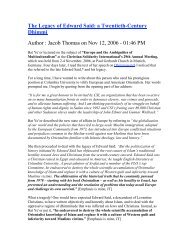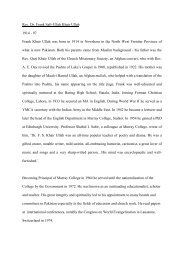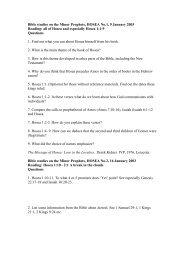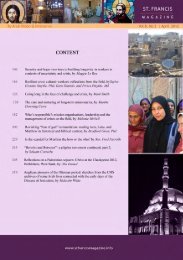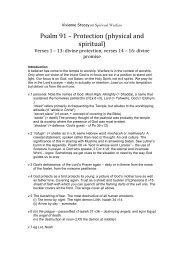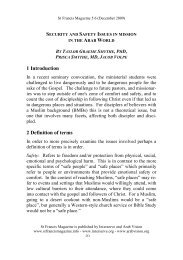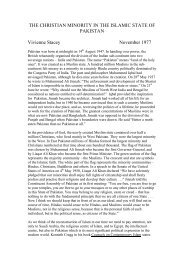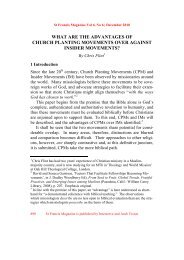Jesus, the Son of God: Biblical meaning, Muslim Understanding ...
Jesus, the Son of God: Biblical meaning, Muslim Understanding ...
Jesus, the Son of God: Biblical meaning, Muslim Understanding ...
You also want an ePaper? Increase the reach of your titles
YUMPU automatically turns print PDFs into web optimized ePapers that Google loves.
St Francis Magazine Vol 7, No 3 | August 2011!What is <strong>the</strong> evidence from <strong>the</strong> Bible that <strong>Jesus</strong> is <strong>God</strong>'s <strong>Son</strong> andthat <strong>God</strong> is His Fa<strong>the</strong>r? Would first-century Jews have understood<strong>the</strong>se terms to be just metaphors or idioms as some have claimed, orra<strong>the</strong>r, as <strong>the</strong>y read <strong>the</strong> inspired writings <strong>of</strong> <strong>Jesus</strong>' disciples would<strong>the</strong>y have understood <strong>Jesus</strong> to be <strong>God</strong>'s <strong>Son</strong> in a more real sense?The New Testament begins with a Jewish author writing to aJewish audience, using a Jewish genealogy to show who <strong>Jesus</strong> is.To move <strong>the</strong> genealogy forward, <strong>Jesus</strong>' disciple Mat<strong>the</strong>w uses <strong>the</strong>verb "fa<strong>the</strong>red" (from <strong>the</strong> Greek verb !"##$%) forty times, so that(following <strong>the</strong> Greek text), "Abraham fa<strong>the</strong>red Isaac, <strong>the</strong>n Isaac fa<strong>the</strong>redJacob... David fa<strong>the</strong>red Solomon..." and so forth, until <strong>the</strong>genealogy reaches its goal/peak and culminates in verse 16 with adivine passive 4 in <strong>the</strong> sentence, "Then Jacob fa<strong>the</strong>red Joseph, <strong>the</strong>husband <strong>of</strong> Mary, from whom <strong>Jesus</strong> who is called Christ was fa<strong>the</strong>red[by <strong>God</strong>]." It is interesting how all five times that Mat<strong>the</strong>wmentions women in <strong>the</strong> genealogy (Tamar, Rahab, Ruth, Uriah'swife and Mary) <strong>the</strong>ir role is not communicated with a verb, but witha prepositional phrase, <strong>the</strong> same phrase "from/by..." (Greek: ""&...")for each one. That pattern works toge<strong>the</strong>r with <strong>the</strong> pattern <strong>of</strong> <strong>the</strong>fa<strong>the</strong>rs' role being communicated through <strong>the</strong> verb <strong>of</strong> each clause torivet attention on <strong>the</strong> final use <strong>of</strong> <strong>the</strong> verb in <strong>the</strong> genealogy when itis suddenly a divine passive, with <strong>God</strong> as <strong>the</strong> implied Fa<strong>the</strong>r. 5!!!!!!!!!!!!!!!!!!!!!!!!!!!!!!!!!!!!!!!!!!!!!!!!!!!!!!!!4 Bible scholars such as Leon Morris, Robert Gundry and Donald Hagner recognizethat Mat<strong>the</strong>w uses a divine passive here.5 Mat<strong>the</strong>w says in 1:17 that <strong>the</strong>re are three sets <strong>of</strong> fourteen generations in his genealogy,but <strong>the</strong>n only lists thirteen men in <strong>the</strong> last set. To remedy this apparentdiscrepancy, some Bible scholars have suggested counting one <strong>of</strong> <strong>the</strong> names in <strong>the</strong>genealogy twice (for example, some include Jeconiah as a member <strong>of</strong> both <strong>the</strong> secondand third sets). However, if it is recognized that <strong>God</strong> is implied as <strong>Jesus</strong>' Fa<strong>the</strong>rin verse 16, <strong>the</strong>n Mat<strong>the</strong>w's count is accurate as is and <strong>the</strong>re is no discrepancy.There is also o<strong>the</strong>r evidence that Mat<strong>the</strong>w intended to have <strong>the</strong> divine passivecomplete <strong>the</strong> pattern for <strong>the</strong> third set in his genealogy. For example, in order tohave fourteen individuals in each set (2 x 7 = double perfection), he left out at leastfour ancestors in <strong>the</strong> second set (including Ahaziah, Joash and Amaziah from betweenJoram and Uzziah in verse 8, and Jehoiakim between Josiah and Jechoniah inverse 11), and he probably left out a few more in <strong>the</strong> third set (which is suggestedby <strong>the</strong> fact that in Luke 3 <strong>the</strong>re are twenty-one, instead <strong>of</strong> only thirteen, men listedfor <strong>the</strong> same time period).St Francis Magazine is published by Interserve and Arab Vision!#!


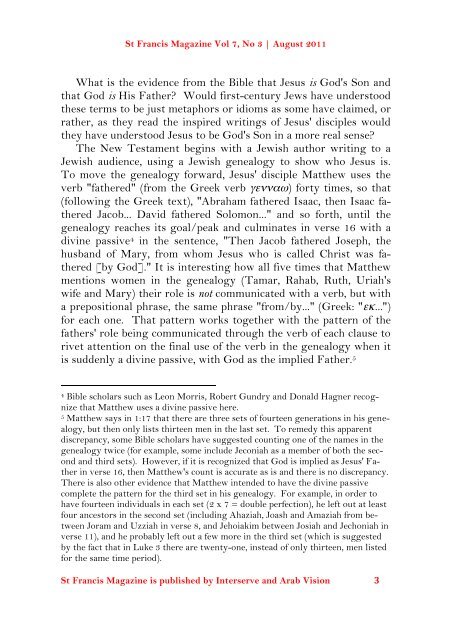

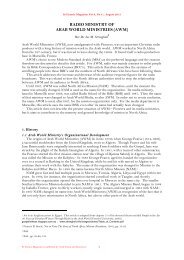
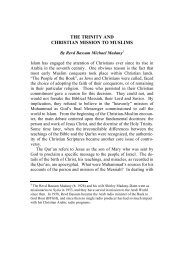
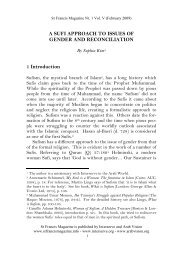
![Reflections on Surah Fatiha and the Lord's Prayer[1] - St.Francis ...](https://img.yumpu.com/49377951/1/184x260/reflections-on-surah-fatiha-and-the-lords-prayer1-stfrancis-.jpg?quality=85)
